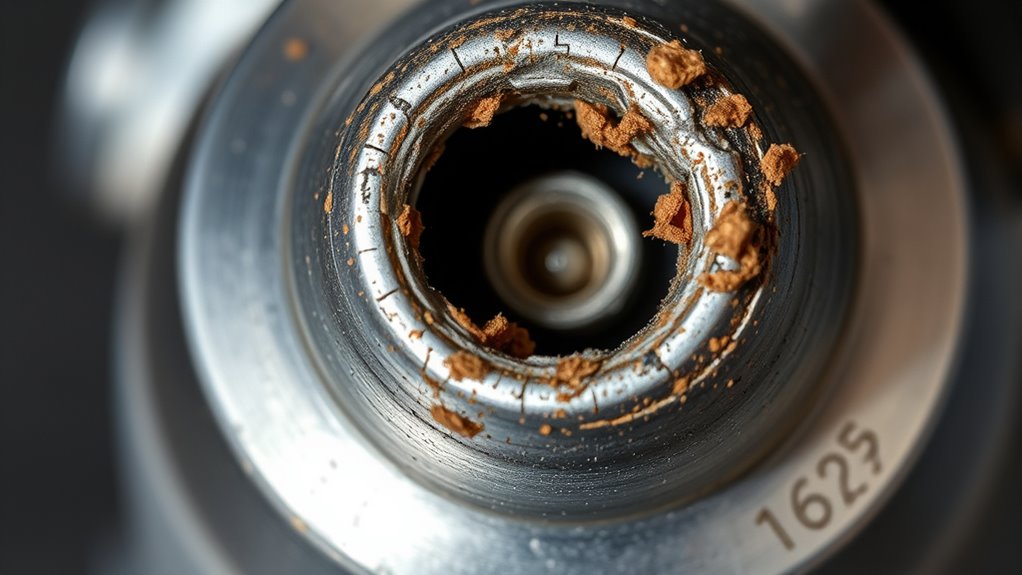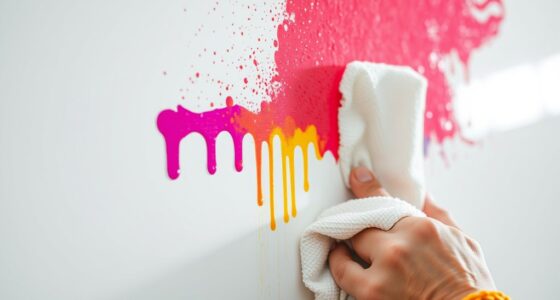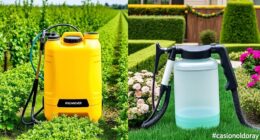If your spray pattern is inconsistent, paint isn’t flowing smoothly, or the spray velocity feels weak, your spray tip might be worn or clogged. Changes in spray shape, uneven coverage, and frequent clogging despite cleaning also signal it’s time for a replacement. Properly preparing your paint can help extend tip life, but persistent issues mean a new spray tip is needed. Keep going to discover more signs that your spray tip may need replacing.
Key Takeaways
- The spray pattern becomes inconsistent or uneven despite cleaning efforts.
- Paint stops flowing smoothly or appears splattered, indicating nozzle clogging or damage.
- The spray velocity weakens or becomes inconsistent, reducing coverage efficiency.
- The spray pattern shape changes, such as narrowing or uneven distribution, signaling tip wear.
- Frequent clogging or irregular spray despite proper maintenance suggests the tip needs replacement.

Your spray tip plays a critical role in achieving a smooth, even finish, so paying attention to its condition is essential. When your spray tip isn’t functioning properly, it can directly impact the quality of your paint job. One of the most common signs that your spray tip needs replacing is inconsistent spray patterns, which often result from issues like improper paint consistency or nozzle clogging. If your paint isn’t flowing smoothly or if you notice splattering or uneven coverage, it’s a clear indication that your spray tip may be worn out or clogged. Sometimes, clogged nozzles cause irregular spray patterns because the paint isn’t atomizing correctly, leading to uneven application. In such cases, cleaning the tip might temporarily fix the problem, but persistent issues often mean it’s time for a replacement.
Another sign to watch for is reduced spray velocity. When your spray tip is worn or damaged, the spray pattern may become weak or inconsistent, making it harder to cover large areas efficiently. This often results from nozzle clogging or a buildup of dried paint within the tip, which restricts fluid flow. If you find yourself needing to go over the same spot multiple times or if the spray isn’t reaching as far as it used to, it’s likely that your spray tip is no longer functioning at its best. Additionally, changes in spray pattern shape—such as a narrow or uneven spray—are telltale signs that the tip needs attention. These irregularities can be caused by a worn-out nozzle, or debris lodged inside, disrupting the uniform distribution of paint.
Paint consistency also plays a key role in the health of your spray tip. If your paint is too thick, it can cause clogging, which in turn affects the spray pattern and flow. Conversely, if the paint is too thin, it might lead to overspray and uneven coverage. Maintaining the correct paint consistency not only guarantees a smooth finish but also prolongs the life of your spray tip. However, even with proper paint preparation, a tip that’s worn or damaged will still produce problems. If you notice frequent clogging despite thinning your paint or cleaning the tip regularly, it might be time to replace the spray tip altogether.
Frequently Asked Questions
How Often Should I Inspect My Spray Tip?
You should inspect your spray tip at least every few painting sessions as part of your maintenance checklist. Regular inspection helps catch issues early, ensuring ideal spray pattern and coverage. If you notice uneven spray, clogs, or damage, replace the tip promptly. Keep a routine inspection schedule to maintain consistent performance, extending the lifespan of your equipment and ensuring professional results each time you paint.
Can a Damaged Spray Tip Affect Paint Quality?
Ever notice uneven paint or drips? A damaged spray tip can definitely influence your paint quality. It messes with the paint consistency and disrupts your spray pattern, causing streaks or missed spots. When your spray tip isn’t in top shape, your finish won’t look professional, and you’ll spend more time fixing issues. Regularly inspecting and replacing worn tips ensures smooth, consistent application and a flawless final coat.
What Tools Are Best for Replacing Spray Tips?
For replacing spray tips, you’ll want an tools overview that includes adjustable wrenches, pliers, and possibly a screwdriver, depending on your sprayer model. Start with the replacement procedures by turning off your sprayer, releasing pressure, and carefully removing the old tip with the wrench or pliers. Then, insert the new tip, tighten securely, and test spray to guarantee proper function. These tools make the process quick and safe.
Are There Different Spray Tips for Specific Paints?
Yes, there are different spray tips designed for specific paints. You need to contemplate paint compatibility to choose the right tip, ensuring smooth application. For instance, thicker paints require larger tips, while thinner paints need smaller ones. Regular tip cleaning helps maintain performance, but if you notice inconsistent spray or clogging, it might be time to replace your spray tip. Always match the tip to your paint type for the best results.
How Do Temperature Changes Impact Spray Tip Performance?
Think of your spray tip as a musician adjusting to each note; temperature changes cause thermal expansion, affecting its performance. As it heats or cools, paint viscosity shifts, making the spray inconsistent. Cold temperatures can cause the tip to contract, reducing spray pattern, while heat causes expansion, leading to uneven application. You need to monitor how temperature impacts your spray tip, ensuring consistent results by adjusting your technique or equipment accordingly.
Conclusion
If you notice uneven spray patterns, frequent clogs, or a significant drop in performance, it’s time to replace your spray tip. Think of your spray tip as the heartbeat of your equipment—when it’s weak or failing, your entire project suffers. Don’t let a worn-out tip turn your perfect finish into a frustrating mess. Replace it promptly to keep your work smooth, efficient, and a reflection of your true craftsmanship.










